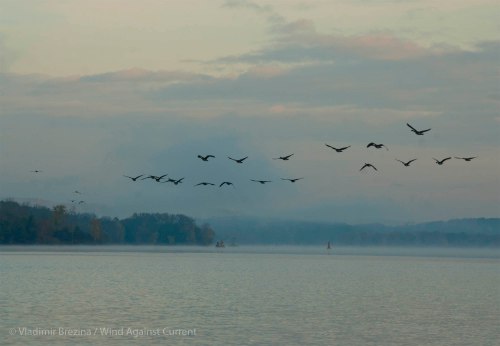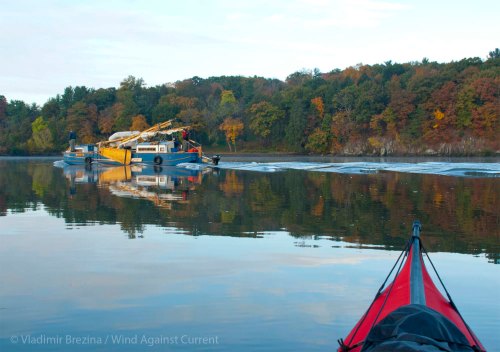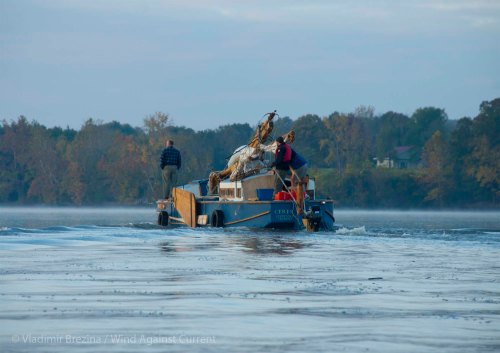By Vladimir Brezina
A week ago, over the Columbus Day weekend, we were kayak-camping at Stockport Middle Ground, one of my favorite places along the Hudson River, to paddle among the Fall colors (story and photos forthcoming!).
So on Monday a week ago, I paddled out onto the still river, shrouded in fog, as the first colors of dawn softened the sky. Honking geese flew overhead.
But what was that strange buzzing sound, and that strange object emerging from the fog upriver, gradually growing bigger?
It was Ceres!
Ceres is the resurrection of a once-ubiquitous but now long-vanished Hudson River craft—a sailing produce barge. The brainchild of Vermont farmer Erik Andrus and his Vermont Sail Freight Project, she was built this past summer and is now on her maiden voyage down the Hudson. In Vermont, she loaded local produce, passed through Lake Champlain and the Champlain Canal, and is now distributing the produce to farmers’ markets and individual customers who have pre-ordered it at various Hudson River towns, with a final stop, a few days from now, in New York City.
Ceres is a shallow-bottomed, boxy little barge. She is 39 feet long, 10 feet wide, yet able to load up to 12 tons of cargo, and fully loaded, drawing only a foot and a half of water—perfect for the shallow waterways she will encounter and for running practically up onto the beach to load and unload cargo. Given that she has no refrigeration on board, the cargo is non-perishable: apples, pears, garlic, carrots, potatoes, winter squash, cider, syrup and honey, baby ginger, dried beans, flour, rice, herbs, preserves and handcrafted soaps. For propulsion, Ceres has a sail rig adapted from that of the traditional Thames sailing barge (with leeboards to preserve the shallow draft), oars for sculling, and if all else fails, an outboard motor. All were on display when I met her, although, sadly, the motor was doing all the work…
In keeping with the retro-romance of traditional human power and sail as well as the modern romance of a lighter carbon footprint, once unloaded the produce is delivered to the customers, ideally, by bicycle.
Here’s the entire vision:
.
But it’s no Luddite project. Ceres has on board modern office technology to keep track of orders. Customers order online, and learn when their orders are approaching by cell phone, text, or email. There is a project website and a blog that is being updated daily with posts beautifully written by Andrus himself as Ceres makes her way down the Hudson. A fruitful marriage of old and new!
At present, Ceres is just a single barge making a trial voyage. But looking to the future, Andrus puts forward an ambitious socio-economic vision for the overall project: nothing less than “the rebirth of working sailing craft, which accomplishes services helping people live with a lighter footprint. We know this is possible because it existed for years. Water transport works. If we can find a way to separate ourselves from the preoccupation with speed, all kinds of openings for alternative approaches to satisfying human needs become viable.”[1]
“Our 2013 voyage is a pilot project, a first step towards a trading system that has potential to be economically viable as well as being ecologically sustainable and socially just. Over time we hope to transition this model from a volunteer-driven project of a non-profit to a for-profit farmer-owned shipping and marketing co-op.”[2]
“In many ways we have our work cut out for us. The [super]market is always able to provide the lowest common denominator food from somewhere inexpensively. We have to tell the story why our neighbors ought to support local agriculture instead of just buying from the cheapest possible source.”[3]
“Nay-sayers say this will never be viable because the labor costs will torpedo the savings in fuel consumption; but maybe not. We’re not really competing head-to-head with the trucking industry. We’re transporters, but also petty merchants. Most truckers are not operating a general store out of the back of their truck. We’re performing two services at once, plus selling the intangibles of the project.”[1]
Here is Andrus presenting his vision, in a video made when the project was still in infancy (you may need to right-click on the video to control it):
.
Andrus hopes that the Vermont Sail Freight Project will be self-sustaining in two years. In the meantime, “Spending time on a slow-moving boat on the river is inherently enriching and fun and soothing and good for the soul, in the way driving a semi on the Interstate is not.”[1]
Will the project succeed? Andrus is clearly a visionary. Yet in his vision he has managed to creatively combine ideas that will appeal to diverse constituencies, to raise tens of thousands of dollars for the project through a Kickstarter campaign and elsewhere, to recruit hundreds of volunteers, to build the barge, to load produce, to find customers, and to actually set sail, all more or less on time and on budget. So who knows?
Some contradictions in the vision have already been exposed, however. Andrus claimed that “we can transport 12 to 13 tons of goods — without consuming a drop of gasoline — 300 miles, from farm to plate, if you will.”[2] But when I saw her, Ceres was motoring along (making quite a racket for an eco-friendly boat!), and had not yet been able to raise sail, it would seem from others’ reports, in the entire hundred miles since leaving Vermont. The first time Ceres was seen sailing was apparently only much farther down the river, with much of the voyage already over. In his blog post of today, October 21st, Andrus acknowledges the difficulty:
“This same weather that has been so kind to us in terms of markets — the beautiful days just go on and on — is not so great for sailing towards the south. Day after day we have the wind right on the nose. This has made for less sailing than I had hoped. This being the first time out, our schedule was laid in pretty far in advance. Schedules and sailing vessels are really a poor match and we’ve done the best we can to balance between being on time so that our land-based partners can plan for our arrival and maximizing sail. Hopefully in the future we’ll be able to develop a more flexible schedule that will have fewer distance imperatives built into it. But for the time being we have the schedule we have and the weather we have, and all together we have a lot to be thankful for as the voyage has gone quite well so far.”
He’s learning the patience, the fatalism, of a sailor…
Ceres is scheduled to arrive in NYC—hopefully in all her sailing glory—in a few days, on October 25 or thereabouts. (The original schedule is here, and a recently updated list of events is here, in the post of October 18.)
Whether by kayak or on land, she’s worth turning out for!
________________________________________________________
Further articles and photos (and sources for the quotes by Andrus):
- [1] Hudson Valley Almanac Weekly
- [2] Kickstarter: The Vermont Sail Freight Project
- [3] CNBC
- New York City Atlas
- Addison County Independent
- The Middlebury Campus
- Yale Environment 360
- Working Harbor Committee (photos)
- Tugster (photos here, here, and here)
- …but the best photos are in Ceres‘ own blog!
________________________________________________________
Update October 27, 2013: Ceres has arrived in NYC, more or less on schedule, and is distributing produce! Tugster has some nice photos here.











Really enjoyed the concept and the video and the music that accompanied it. Perfection is elusive but the concept is sound and I hope it continues. I wonder the origins of the lyrical name Ceres ?
LikeLike
Just loved the story and I hope it prevails. Perfection is elusive like the wind evidentially but the concept is romantically sound. The Video and music were also very entertaining. I wonder the origin of the lyrical name Ceres?
LikeLike
If you mean why Ceres is called Ceres, Ceres was the ancient Roman goddess of agriculture—a very appropriate name for the barge, therefore.
The etymology of the name “Ceres”, in turn, is obscure, as usual.
LikeLike
I thought of googling it but I KNEW you would know : )
LikeLike
:-)
BTW, all of your comments are going into the spam filter all of a sudden. Is the problem at our end or at yours? Not sure yet. In any case, no damage done because I look through the spam filter often, for exactly this reason. But it might be happening to you on other blogs too.
LikeLike
It is happening to all of my blogs and answers :(
LikeLike
I thought I would try again. I have sent WP 6 messages and have not heard one single thing yet….considering that WP is my only social outlet I am pretty bummed.
LikeLike
Not sure what you can do, but answers to the same issue that others had earlier in the year are not encouraging… :-(
LikeLike
I know….sigh…I was getting some momentum toooo
LikeLike
Unfortunately, you get what you pay for—and actually, most of the time you get what you would have got if you paid nothing even if you do pay something. The prevailing model these days for answering complaints and solving problems seems to be “wisdom of the crowds”, which may get your problem resolved efficiently, or not at all. Google works on the same principle…
LikeLike
I paid for an upgraded website and features. I am VERY unhappy. I am going to keep trying to write to you as at least you check your spam. WordPress actually deleted my public inquiry and told me to write to Akismet : ((((
LikeLike
Still ending up in spam :-(
LikeLike
How about now Vlad?
LikeLike
Three others got my comments but not you..It’s s frustrating!
LikeLike
Still going to spam…
LikeLike
I think after 14 hysterical emails it’s fixed. You tell me please Vlad?
LikeLike
I believe it is—congratulations!! :-)
LikeLike
Oops it wasn’t me, the first one vanished : )
LikeLike
It went into the spam filter, from where I rescued it. It happens :-)
LikeLike
Weird , it’s still acting up now…
LikeLike
Doesn’t even show my comment after I KNEW….hmmmm
LikeLike
That’s totally cool. Great post, great project.
LikeLike
Yes, it will be fascinating to see whether it catches on…
LikeLike
I would turn out for her, if I could! What a neat idea. Love all the colors on the river banks.
LikeLike
Lots more photos of those colors coming up soon, I hope! They were indeed spectacular, in places…
LikeLike
Quite interesting…thanks for sharing…Love the concept…
LikeLike
Great! You are most welcome :-)
LikeLike
I like such visionaries. I wish them luck and thank you for the photos, colours and mood!
LikeLike
They will need all the luck they can get, but they have been surprisingly successful so far, I think…
LikeLike
Erik, the night before he passed SMG, at Coxsackie Dock reflected on the historical reality of towing barges through the canal system, scheduled sailing impossible then & now.
Spoiled by Lake Champlain, the tidal Hudson much more difficult to navigate by sail. Yesterday, to establish my Quixote credentials, paddled out of Annsville, almost to Garrison, hoping to observe Ceres tacking through the Highlands. Five hours of hopelessness. A mostly southerly wind blew which he may welcome back when he returns to Vergennes.
Heading back after crossing above Jones Point reverted to Sancho Panza — the towers at Indian Point aren’t windmills!
LikeLike
Before there were outboard motors, sailing barges in the Hudson would have had to wait for favorable wind, of course, no matter how long it took. That must have really messed up the shipping schedules.
It brings to mind the phrase “when my ship comes in”. Especially if your ship was sailing around the world, she might be months, even years, overdue, and then suddenly one day there she would be! Or not.
Erik has a partial answer to this. In the blissful future when there are 200 barges such as Ceres plying the Hudson that at any moment are in different stages of their voyage, one will always arrive reasonably soon. Arrival will still be unpredictable, but at least with finer granularity.
It’s noticeable that the voyage back hasn’t been given nearly as much thought as the voyage out. There was a plan to load up with city goods to ship back to Vermont, and so establish a nice trading loop, but I don’t think that has been worked out in detail yet. Of course, they could put Ceres on a truck and be back in Vermont in half a day, but after that they could never show their face in public again :-)
And of course, as Erik mentions, this is the last possible time of year when Ceres‘ voyage could happen. After this, everything will shut down for the winter. The next voyage will be, perhaps, in the spring…
LikeLike
Lovely, lovely post, Vladimir. Can’t think of anything more wonderful than a sailing farmers’ market, bringing all that delicious Vermont produce. Here in Shropshire we used to have big sailing barges on the River Severn – called trows. Likewise the Thames used to have many sailing barges with ox-blood coloured sails – most now consigned to museums and the odd tourist vessel. Hey ho.
LikeLike
Thanks, Tish! :-)
I think Andrus had the traditional Thames sailing barge, among others, in mind as inspiration not just for Ceres‘ sail rig but for the overall concept. He says that “English Thames Sailing Barge Rigs were refined to a high degree of [efficiency to be operated] by a crew of two, often an old man and a boy. They remained cost-competitive with road and rail freight in England until the 1970s.”
But, as you say, the few left now are just tourists boats, and there’s a reason for that. Andrus wants his barges to be both an interesting, fun, eco-friendly way of delivering produce, and an efficient way compared to rail and road. He may find that the two aims are simply not compatible…
LikeLike
Like the top one of these three.
LikeLike
Thanks, Mike!
LikeLike
I hear TED calling. . .
LikeLike
Very possibly so…
LikeLike
I dream of living on the water… European rivers and canals can offer the solutions but alas, I have to somehow convince my GLW… not easy! ;-)
LikeLike
A nice canal houseboat, long but (of course) narrow… I can see that! :-)
LikeLike
No!! Never narrow… that’s like living in a passage. No, for me it must be something about 40 meters long, beam between 6 and 8… strong green (diesel) motor.. ) I dream… ;-) But, never a narrow boat!! :-P
LikeLike
Something like this?
LikeLike
I so enjoyed this post, pictures, theme, and your writing. I am living on a small sailboat in Mexico, with a kayak, presently in the Bay of Banderas, waiting for a big storm to pass through and then we’ll sail south
LikeLike
Must be a great life (once you get used to it)! Good luck, and thanks so much—happy that you enjoy our posts!! :-)
LikeLike
Pingback: Boundary Conditions: Exploring the Hudson River in Autumn | Wind Against Current